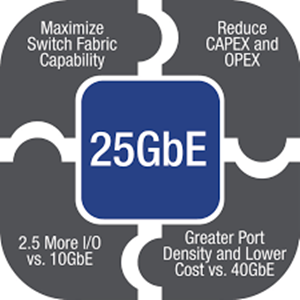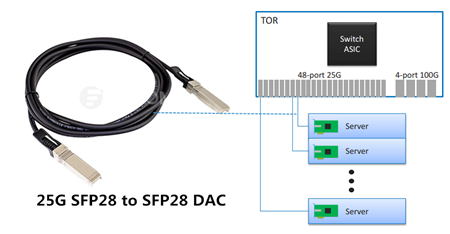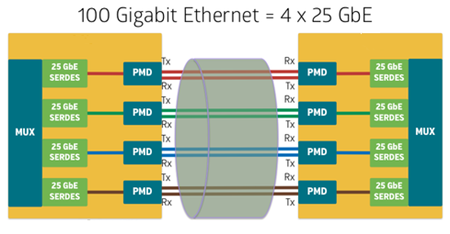25G Ethernet, developed by IEEE 802.3 task force P802.3by is a newly proposed standard for Ethernet connectivity. After its appearance, the road to 100G is considered to be 10G→25G→100G. 25G Ethernet may be the quickest path to completion IEEE Ethernet standards effort to 100GbE. To unveil the mask of the mysterious 25G standard, this post offers some answers to help you sort it out.
What is 25G Ethernet? Do you mean 25G electrical lanes used for 100G Ethernet?
No, it is a proposed standard for Ethernet connectivity that will benefit cloud and enterprise data center environments. 25 GbE leverages technology defined for 100 Gigabit Ethernet implemented as four 25 Gbit/s lanes running on four fibers or copper pairs. Just think of it as 10G Ethernet sped up 2.5 times.
Why Choose 25G?
The most obvious feature of 25 Gigabit is described in two words—single lane. The phrase refers to the electrical signaling on the chip that would power an Ethernet port, while the design of 40 GbE was based on 10 GbE. Originally, 100 GbE had a similar heritage, with its initial design in 2010 using 10 lanes of 10 Gbps. This is the first generation of 100G transport links. As standards bodies sought to improve the efficiency of 100 GbE in the coming years, its second generation consists of four lanes of 25 Gbit/s Ethernet on four fiber or copper pairs. This will be disruptive to the 10G and 40G infrastructure.

In addition, the proposed 25 GbE standard reduces the number of lanes on the chip makes it less expensive to produce and less power-hungry. It also simplifies the process with just minor changes for forward error correction and lane alignment when compared to 40 GbE. To sum up, getting 25 GbE performance for the same price of 10G combined with reduced operating costs, which makes itself a compelling proposal for migration.
Last but not least, moving from 10G to 40G is a big jump and it turns out the incremental cost of 25G silicon over 10G is not that great.
Will 25G be available through both copper and fiber connectivity?
Yes. IEEE 802.3 work is currently underway to specify 25Gb/s on twinax (direct attach copper) to 5 meters, printed circuit backplane up to 1m, twisted pair copper to 30m, multimode fiber to 100m. There are some vendors working on 2km reach optics over single mode fiber.
Which interface form factors are used?
QSFP28 is used for 4x25GbE and SFP28 is used for a single 25GE port.
Are these form factors related to QSFP+ and SFP+?
Yes. The new form factors are the same size as their older counterparts but designed for 25G lane speeds vs. 10G for the older form factors. SFP28 connectors and modules are required for 25GbE because they give better performance than SFP+ that only works to 10GbE.
What is 25G SFP28 cable?
The IEEE CFI is now focused on the SFP28 and QSFP28 direct attach copper twinax cables (DACs). 25G SFP28 refers to the 25G DAC cable using the SFP+ form factor, and QSFP28 DAC refers to the 100G DAC cable using the QSFP+ form factor. The maximum transmission distance of these cables is 5 meters. Figure 2 shows the diagram of the 25G SFP28 DAC cable.

There are two SFP28 DAC types: 25G SFP28 to SFP28 DAC and 100G QSFP28 to four SFP28 breakout DAC. The SFP28 to SFP28 passive copper cable is a high speed, cost-effective 25Gbp/s Ethernet connectivity solution designed to meet the growing needs for higher bandwidth in data centers. The QSFP28 to four SFP28 breakout DAC is used to connect 100G switches to four 25 Gigabit in cabinet or adjacent cabinet servers. Compared to 40G using four 10G lanes and 100G using 10 10G lanes, the 25G SFP28 DAC provides the low-cost copper server connection for Top of Rack (ToR) switches.
What about 28G? Is that a typo?
No. Ethernet is not the only application for these form factors, so there may be other higher-speed interface uses for them.
Are these the only form factors in use?
The industry is standardizing on these but there may be other solutions as switching fabric capacity increases beyond what QSFP28 can support in switch faceplate density. Recently Cisco has launched a new 100G optical transceiver module—CPAK for longer distance.
100GE SR4 and CR4 specifications require RS-FEC, does 25GE need FEC?
Yes and no. There are two FEC modes (BASE-R FEC and RS-FEC) and both are optional copper interconnects (DACs).
Do I need FEC? What are the advantages and disadvantages?
There is a latency penalty when using FEC. If you are designing for HFT applications this will be important to you. The benefit of FEC is it greatly reduces the number of uncorrected errors across the media and helps to extend the usable reach of those media. It's estimated to be 80ns or 250ns for BASE-R and RS-FEC respectively.
Are there other disadvantages besides latency?
There is a very small power consumption hit estimated between 25mW and hundreds of mW per port. Not a lot but it may matter to someone with over a million servers to connect!
What’s the technical limitation as speeds go higher and higher?
A number of factors limit speeds going faster and faster, but the main problem is that materials attenuate signals as they travel at higher frequencies.
Can I use 10G or 40G DACs in my 25G network?
No. 40G DACs are not designed to run at 25G per lane speeds (they run at 10G speeds).
Can I split my 100GE interface into 4x25G?
Many top of rack (ToR) switches are designed for operation at 100, 50, 40, 25 and 10G speeds, so if you have one of those switches it will run in 4x25G mode (see in Figure 3) from each QSFP28 port.

Will the IEEE 50G be a 2x25G design?
No. The IEEE is targeting to complete 802.3by in the first half of 2016. Any 50G serial standard is expected to be out in 2018 at the earliest. The industry is trying to get to the next level of efficiency by defining a set of 50G serial standards.
What kinds of 25G ports are on the market today?
The first GA products are starting to ship right now. These are ToR switches, server NICs and DACs, of which 25G SFP28 has been matured.
100G Migration? Will the path be 10G→25G→100G?
Before the appearance of 25G, the migration path to 100G is considered to be 10G→40G→100G. But recently many companies are turning to put forward 25G technology and supporting devices. Therefore, only time will tell how this all plays out but in the meantime, there is a richness of choice in the 100G interconnect market.
评论
发表评论